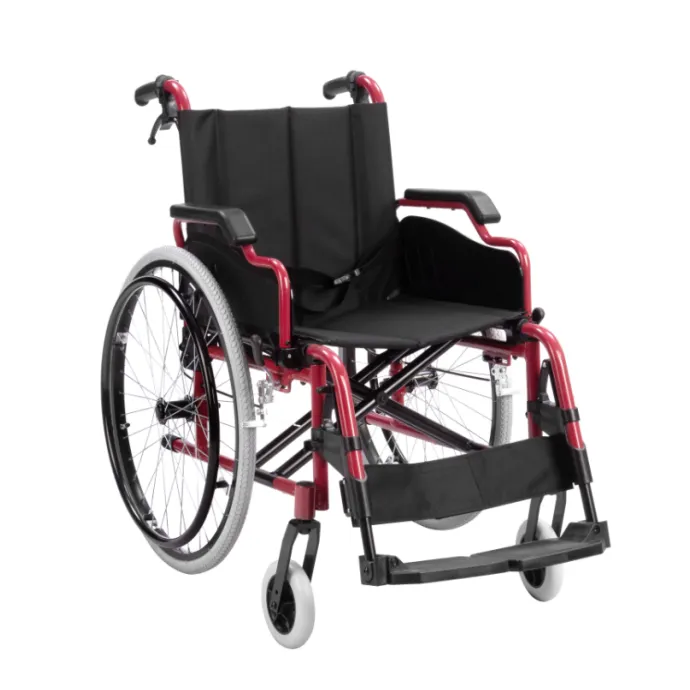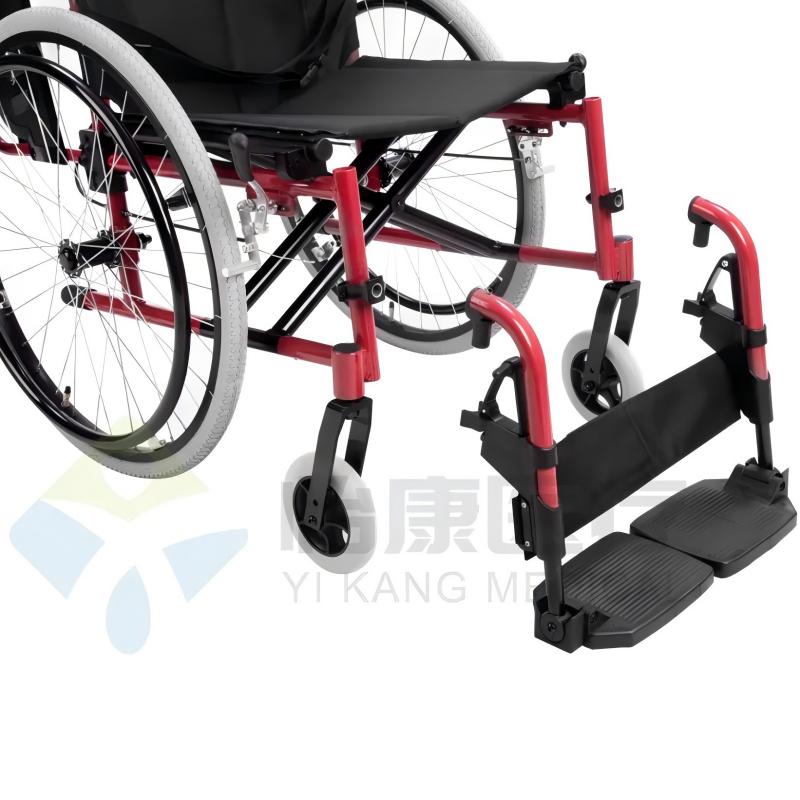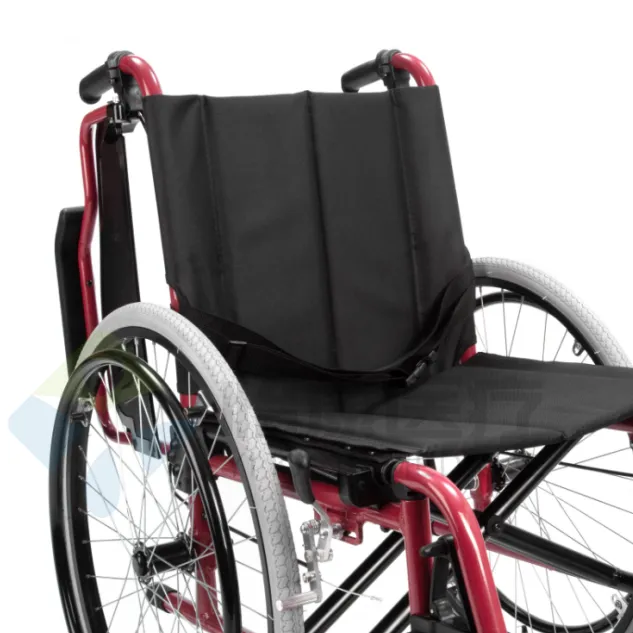With the continuous improvement of the quality of life of people with mobility impairments in modern society, the application scope of assistive walking devices is becoming increasingly wide. Among them, manual wheelchairs, especially standard manual wheelchairs, as a basic type of wheelchair that does not require electric drive and relies entirely on human operation, have long been widely used in clinical, community, rehabilitation and home care.
Focusing on the topic of "Who will use a manual wheelchair?", this article will conduct a professional and structured discussion, combining multiple factors such as the physical condition of the user, the care environment, and the operation requirements, to comprehensively analyze the applicable population and related background of manual wheelchairs, especially standard manual wheelchairs.

What is a manual wheelchair?
A manual wheelchair is a non-electric assistive device that is moved by the user himself through a push ring to drive the rear wheels, or by others pushing from the back. Its core features are: no power system, no motor control, and completely relying on human operation. The typical manual wheelchair structure includes a seat frame, a large-diameter rear wheel, a rotatable front wheel, a footrest, an armrest, a backrest, and a foldable or fixed beam structure.
What is a standard manual wheelchair?
The standard manual wheelchair is the basic model among manual wheelchairs, with the following core features:
• Equipped with a 24-inch large rear wheel, it can be self-propelled through a push ring;
• The structure is stable and the load-bearing capacity is moderate, suitable for medium-sized users;
• Most of them have a foldable frame for easy transportation and storage;
• Suitable for environments such as hospitals, homes, and rehabilitation centers;
• Usually weighs between 12-18 kg and is made of metal or alloy.
Due to the balance of cost, structure, and adaptability of the standard manual wheelchair, it has become the most common type of manual wheelchair for clinical use and personal purchase.

Who needs to use a standard manual wheelchair?
To explore "who will use a manual wheelchair", it is necessary to clarify the characteristics of the population. These people usually face varying degrees of lower limb activity disorders, reduced balance function, or temporary mobility difficulties, and meet the conditions of operation, physical fitness, and scene adaptation. The following lists the main applicable population categories.
People who need to use standard manual wheelchairs include:
1. People with short-term mobility restrictions
2. People with mobility difficulties caused by chronic diseases
3. Elderly people
4. Patients with spinal cord injuries
5. Patients who are bedridden for a long time but can sit up
1. People with short-term mobility restrictions
This group of people is usually temporarily unable to walk independently during the recovery period due to trauma, surgery or disease.
• Postoperative rehabilitation patients: For example, after knee replacement and fracture internal fixation, patients need to use standard manual wheelchairs to achieve spatial mobility in the early stage.
• Lower limb fracture rehabilitation patients: Using crutches is not stable yet, and wheelchairs become a safer choice.
• Short-term patients with nerve damage: Such as spinal cord concussion and lower limb weakness caused by temporary nerve compression.
Standard manual wheelchairs are very suitable for temporary users due to their stability and easy propulsion. They can be pushed by themselves and are also easy for caregivers to assist in pushing.
2. People with mobility difficulties caused by chronic diseases
Some chronic diseases such as Parkinson's disease, multiple sclerosis, diabetic neuropathy, etc. can cause inconvenience in walking. This group of people often choose standard manual wheelchairs as medium- and long-term mobility tools.
•Parkinson's patients: Tremors and muscle stiffness make walking unstable, and manual wheelchairs provide safety protection.
•Diabetic patients: Late stage can cause lower limb neuropathy, leading to gait disorders, and manual wheelchairs become a key daily mobility tool.
•Patients with joint degenerative diseases: For example, severe osteoarthritis, unable to walk with weight for a long time.
Standard manual wheelchairs can achieve functional compensation and reduce the risk of falls in these groups.
3. Elderly people
Old people may gradually lose the ability to walk independently due to muscle weakness, poor balance, osteoporosis and other reasons. For such people, especially in home care scenarios, standard manual wheelchairs are the first choice with high cost performance and good safety.
•People over 75 years old and unstable walking;
•Elderly people with a history of falls;
•People with insufficient walking endurance due to weakened cardiopulmonary function.
Manual wheelchairs, especially standard models, provide a solution that takes into account both safety and applicability, which is convenient for home care and suitable for outdoor activities.
4. Patients with spinal cord injury
For some patients with spinal cord injury, especially those with injuries below the thoracic segment, although the patients cannot use their lower limbs, they retain good upper limb function and can achieve self-drive through a standard manual wheelchair. Such users often rely on wheelchairs for a long time and develop very efficient self-care ability.
•T12-L1 spinal cord injury;
•Complete injury but normal upper limb function;
•Wheelchair skills training is required to achieve self-care.
The push ring design, self-propelling performance and adjustable components of the standard manual wheelchair make it the core mobile device for this type of user.
5. Patients who are bedridden for a long time but can sit up
For some people who are bedridden due to chronic diseases or old age, during the rehabilitation period or transfer needs, a standard manual wheelchair will be used regularly as a transition tool between bed and chair to promote blood circulation and prevent pressure sores.
•Bedridden for a long time but conscious and able to sit up;
•Need to sit up regularly to improve respiratory function;
•Transfer is assisted by a caregiver.
Although this group of people cannot push themselves for a long time, they can also achieve efficient indoor mobility with the help of others.

Why don't everyone use electric wheelchairs?
With the advancement of technology today, many people mistakenly believe that electric wheelchairs should replace manual wheelchairs. In fact, standard manual wheelchairs still have irreplaceable advantages on many levels.
1. Higher applicability and environmental adaptability
Standard manual wheelchairs do not require power, controller or battery maintenance, and can be used in a variety of complex indoor and outdoor venues. They are especially suitable for barrier-free places such as medical institutions and rehabilitation centers.
2. Easy to operate, suitable for primary users
For the elderly or temporary users, standard manual wheelchairs have a low threshold for use and do not involve complex operations. They are easy for caregivers to control and reduce learning and adaptation costs.
3. Cost and maintenance advantages
Compared with electric wheelchairs, standard manual wheelchairs are low in price, easy to maintain, and have strong versatility in parts. They are ideal for large-scale purchases by home care and medical units.
Who is not suitable for using standard manual wheelchairs?
Reverse analysis helps to clarify the boundaries of "who will use a manual wheelchair":
• People with upper limb dysfunction: such as severe rheumatism, frozen shoulder, and brachial plexus injury, who cannot effectively push;
• People with severe cognitive impairment: such as severe Alzheimer's disease patients, who cannot understand or cooperate with the use of wheelchairs;
• Completely paralyzed and without nursing support: Users who rely on electric systems or complex care methods are not suitable for using standard manual wheelchairs.

Typical user portrait of standard manual wheelchairs
In summary, as the main type in the field of manual wheelchairs, standard manual wheelchairs are designed for people with "partial functional limitations, sound cognition, and moderate external support".
Manual wheelchair users include:
1. Postoperative rehabilitation patients;
2. People with chronic diseases that limit walking;
3. Elderly people who still have upper limb strength;
4. People with middle spinal cord injuries but upper limb function;
5. Long-term bedridden people with partial paralysis but clear consciousness and good physical strength.
For these users, a standard manual wheelchair is not only a means of transportation, but also a key means to achieve independence, reduce care intensity, and improve quality of life.
Who is Yikang Medical and What Do They Specialize In?
Foshan Yikang Medical Technology Co., Ltd is a professional manufacturer and supplier based in China, specializing in the production of hospital furniture and rehabilitation equipment. Our product range includes hospital beds, nursing beds, wheelchairs, commode chairs, shower chairs, walkers, crutches, and other mobility aids. With certifications like ISO13485, ISO9001, CE, and FDA, we ensure high-quality standards across our manufacturing process.

